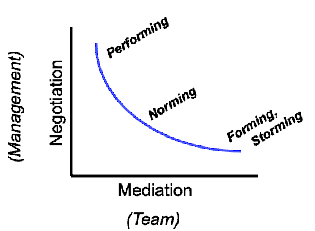The jump from traditional software practices to agile can be daunting for some project managers. After all, agile teams are all about "self-organizing," right? What's a manager to do? Michele Sliger has encountered a fair number of worried project managers and, in this article, offers a more uplifting perspective.
I often field concerns from traditionally trained project managers as to how their job will change if they shift to an agile software development approach. One of their biggest concerns is what they are expected to do once their teams begin self-organizing. Here's the answer: Once your team's need for your guidance diminishes, your focus will turn to external forces that affect your team, and you'll work to increase these forces' positive influence and decrease or eliminate their negative influences. All agile project managers become agents of organizational change.
The chart below shows where the project manager's focus will lie, depending on where the team is in the Tuckman Model of group development (see Figure 1). The Tuckman model was created by Bruce Tuckman in 1965 and illustrates the stages a team goes through as it matures and learns how to function smoothly as a unit.
 |
| Figure 1 |
When the team is new (or new to working together in an agile environment) they are in Tuckman's forming stage. This is the honeymoon phase, where all are on their best behavior as they learn about the project vision and goals. Following forming, the storming stage is characterized by team members in conflict over differing ideas, perspectives, and interpretations of the issues. In the forming and storming stages, an agile project manager focuses most of her time and energy on the team. She begins by helping them to understand agile and making sure they are communicating with one another, and then moves into mediating disagreements and disputes between members of the team. This is part of the guidance the project manager provides in helping teams learn how to work together successfully and reach consensus on decisions.
As the team moves up the curve to the norming phase, they will have resolved most of the issues they have control over, such as how to set up their environments, what tools they'll be using, how they'll approach configuration management, etc. The next set of issues the team begins to raise are typically external forces, or those that are outside the sphere of influence of the team. The project manager starts to split her time between coaching the team and negotiating solutions with those who own the external forces—i.e. the external influencers. These entities are more often than not "management," but can also include vendors, legal staff, customers, and peers.
I make a distinction between mediation, which I view as a tool the agile project manager uses with the team, and negotiation, a tool used with external influencers. As an agile team is designed to be self-organizing and make decisions about how to deliver the product, the agile project manager has the responsibility of helping team members learn how to work together to become a high-performing team capable of achieving consensus. Mediating problem resolution discussions allows the project manager to assist the team in this process without taking ownership of the solution.
When working with external influencers, the agile project manager represents the team as a part-owner of the system and thus negotiates as an owner for better situations for her team. Systems thinking becomes critical for the project manager to master, as the main topics of negotiation are around how to improve the flow of value through the entire value chain—of which her team is a part. This is where her role as an agent of organizational change becomes readily apparent, if it hasn't already.
The next phase in team development is when the team moves from norming, where they have all learned how to work together to achieve a common goal, to performing, where the team members are a cohesive unit that need little supervision in reaching consensus and taking action. They have a solid record of delivering value to customers and have become more proactive than reactive. The agile project manager's focus is now almost entirely on negotiating solutions to organizational issues. You can see how the chart in figure 1 illustrates this shift from team-facing mediation activities to management-facing negotiation strategies as the team reaches the top of the curve—the performing stage—in the Tuckman model.
Traditional project managers should approach their transition by learning how to apply agile practices tactically at the team level, as well as understanding how to embrace agile and systems thinking strategically as an agent of organizational change. From focusing on the team during their forming, storming, and norming phases to focusing on the organizational changes needed to support a high-performing team, the agile project manager's key strength will be her versatility and understanding of the nature of situational leadership. Like the process she is supporting, the project manager, too, will have to be agile.

